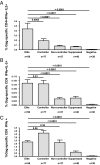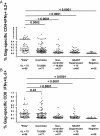HLA class I-restricted T-cell responses may contribute to the control of human immunodeficiency virus infection, but such responses are not always necessary for long-term virus control
- PMID: 18353945
- PMCID: PMC2395228
- DOI: 10.1128/JVI.02176-07
HLA class I-restricted T-cell responses may contribute to the control of human immunodeficiency virus infection, but such responses are not always necessary for long-term virus control
Abstract
A rare subset of human immunodeficiency virus (HIV)-infected individuals maintains undetectable HIV RNA levels without therapy ("elite controllers"). To clarify the role of T-cell responses in mediating virus control, we compared HLA class I polymorphisms and HIV-specific T-cell responses among a large cohort of elite controllers (HIV-RNA < 75 copies/ml), "viremic" controllers (low-level viremia without therapy), "noncontrollers" (high-level viremia), and "antiretroviral therapy suppressed" individuals (undetectable HIV-RNA levels on antiretroviral therapy). The proportion of CD4(+) and CD8(+) T cells that produce gamma interferon (IFN-gamma) and interleukin-2 (IL-2) in response to Gag and Pol peptides was highest in the elite and viremic controllers (P < 0.0001). Forty percent of the elite controllers were HLA-B*57 compared to twenty-three percent of viremic controllers and nine percent of noncontrollers (P < 0.001). Other HLA class I alleles more common in elite controllers included HLA-B*13, HLA-B*58, and HLA-B*81 (P < 0.05 for each). Within elite and viremic controller groups, those with protective class I alleles had higher frequencies of Gag-specific CD8(+) T cells than those without these alleles (P = 0.01). Noncontrollers, with or without protective alleles, had low-level CD8(+) responses. Thus, certain HLA class I alleles are enriched in HIV controllers and are associated with strong Gag-specific CD8(+)IFN-gamma(+)IL-2(+) T cells. However, the absence of evidence of T cell-mediated control in many controllers suggests the presence of alternative mechanisms for viral control in these individuals. Defining mechanisms for virus control in "non-T-cell controllers" might lead to insights into preventing HIV transmission or preventing virus replication.
Figures






References
-
- Altfeld, M., E. T. Kalife, Y. Qi, H. Streeck, M. Lichterfeld, M. N. Johnston, N. Burgett, M. E. Swartz, A. Yang, G. Alter, X. G. Yu, A. Meier, J. K. Rockstroh, T. M. Allen, H. Jessen, E. S. Rosenberg, M. Carrington, and B. D. Walker. 2006. HLA alleles associated with delayed progression to AIDS contribute strongly to the initial CD8+ T cell response against HIV-1. PLoS Med. 3e403. - PMC - PubMed
-
- Bailer, R. T., A. Holloway, J. Sun, J. B. Margolick, M. Martin, J. Kostman, and L. J. Montaner. 1999. IL-13 and IFN-γ secretion by activated T cells in HIV-1 infection associated with viral suppression and a lack of disease progression. J. Immunol. 1627534-7542. - PubMed
-
- Bennett, M. S., H. L. Ng, A. Ali, and O. O. Yang. 2008. Cross-clade detection of HIV-1-specific cytotoxic T lymphocytes does not reflect cross-clade antiviral activity. J. Infect. Dis. 197390-397. - PubMed
Publication types
MeSH terms
Substances
Grants and funding
- P30 MH062246/MH/NIMH NIH HHS/United States
- AI44595/AI/NIAID NIH HHS/United States
- AI055273/AI/NIAID NIH HHS/United States
- R01 AI057020/AI/NIAID NIH HHS/United States
- AI052745/AI/NIAID NIH HHS/United States
- AI47062/AI/NIAID NIH HHS/United States
- R21 AI055273/AI/NIAID NIH HHS/United States
- R01 AI044595/AI/NIAID NIH HHS/United States
- R01 AI052745/AI/NIAID NIH HHS/United States
- UL1 RR024131/RR/NCRR NIH HHS/United States
- DP1 OD000329/OD/NIH HHS/United States
- UL1 RR024131-01/RR/NCRR NIH HHS/United States
- AI43864/AI/NIAID NIH HHS/United States
- U01 AI043864/AI/NIAID NIH HHS/United States
- P30 MH62246/MH/NIMH NIH HHS/United States
- R01 AI047062/AI/NIAID NIH HHS/United States
- R01 AI043864/AI/NIAID NIH HHS/United States
- AI057020/AI/NIAID NIH HHS/United States
LinkOut - more resources
Full Text Sources
Other Literature Sources
Medical
Research Materials

